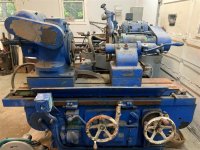Browning1932
Plastic
- Joined
- Jan 25, 2020
Very large and heavy 3 phase. Cincinnati grinder. 200..00 bo. Pics coming soon
Follow along with the video below to see how to install our site as a web app on your home screen.
Note: This feature may not be available in some browsers.
That is a Universal OD at least (see swiveling work head) and I'll guess its old enough to be mechanical - no hydraulics
I’m in wells Maine. 20 minutes north of New Hampshire border. I’m not sure if it runs. My phase converter is to small to run it. I guess define hurry lol





They are code words in the strictest sense of the term. Telegraph codes. Back in the day, you paid for telegraphs by the word. It was routine for manufacturers to give a one-word (usually five letter) ordering code for each different model, so stingy customers did not get into trouble by leaving out too many words of a machine/model description.I love the code words identifying the various models in the catalog: DANCE, DANDY,
DAPLE, DARNE, etc. Code words, were they war production?
Notice
This website or its third-party tools process personal data (e.g. browsing data or IP addresses) and use cookies or other identifiers, which are necessary for its functioning and required to achieve the purposes illustrated in the cookie policy. To learn more, please refer to the cookie policy. In case of sale of your personal information, you may opt out by sending us an email via our Contact Us page. To find out more about the categories of personal information collected and the purposes for which such information will be used, please refer to our privacy policy. You accept the use of cookies or other identifiers by closing or dismissing this notice, by scrolling this page, by clicking a link or button or by continuing to browse otherwise.
